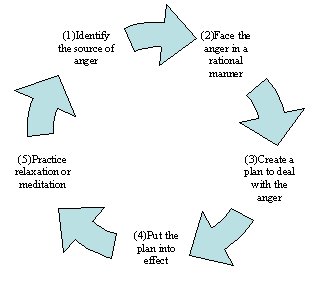- By Matthew P. Binkewicz
- Around Town
 Print
Print Anger is a signal that things are not going our way. It is a response to a thought, feeling, or action that demands immediate attention. Hoping it will go away or merely ignoring its presence will lead to physical, psychological, and spiritual decay for ourselves and those around us. Fortunately, there is a way to break out of the anger cycle.

Anger is directly related to our thoughts. An event occurs that produces a feeling of anger in our life. We process this feeling and usually allow it to linger in our mind until it becomes a thought. This thought takes on a life of its own, so to speak, and takes root within us. If ignored, the anger begins to grow from the “thought” phase into an “action” phase whereby some may retaliate with hostile language or aggressive behavior.
It is at the thought stage that most anger can be dealt with in a rational and relatively short period of time. Anger is like a weed: in its early stages, a weed can be pulled out of the ground quickly and effortlessly with little or no damage to the plants around it. However, if left unchecked, weeds can literally “choke” other plants by robbing them of water, nutrients and sunlight.
Find a place that provides you with the quiet and privacy you will need to achieve this task. Sit on a chair or a cushion and take three deep breaths to clear your mind. Determine which word, person, or situation triggered your feeling of anger. Once you have identified this trigger, you can move forward in dealing with your anger.
Step 2: Face the anger in a rational manner
We must meet our anger head on and not avoid it. In a calm and relaxed manner, examine the source of anger in your life. Identify the feelings of guilt, remorse, embarrassment, rage, fear, and depression that are feeding the seeds of anger in your life. Once you identify the trigger event that causes the anger in your life and give it a name, it will be easier to develop a strategy to deal with the anger. Whether real or imaginary, you will need to give it a name if you wish to break free of the anger cycle.
For example, by using “I statements” to express the feelings of anger, you might be better able to name exactly what is the source of anger in your life.
Step 3: Create a plan to deal with the anger
When faced with any adversarial situation, all of us need some plan to counter its effect. Anger is no exception. Once you have identified and faced your anger in a rational manner, you need to have a plan to deal with the anger. What can you do to stop anger before it robs you of your dignity and humanity?
Certain words in a conversation may be the seeds of anger in your life. When talking with family or colleagues at work, ask them to avoid language that you feel are trigger words. How we speak and the way others speak to us can plant thoughts of anger in our minds. A simple request to rephrase what another person has just said can avoid misunderstanding—the seeds of anger. Careful listening is also a skill that each of us should develop. An attentive ear will eliminate a lot of potential conflict in our lives.
If your anger originates with certain people, find ways to let them know how you feel in a helpful manner. By pointing out their positive attributes along with those that stir up feelings of anger, you might find that they were completely unaware of any harm they may have caused. If they are unwilling to engage in any beneficial activity, then you ought to avoid any further one-on-one situations. Try to meet with them in group settings or communicate through email as long as this does not jeopardize your employment at work or a relationship at home.
(Continued next week)
----
v3i1



